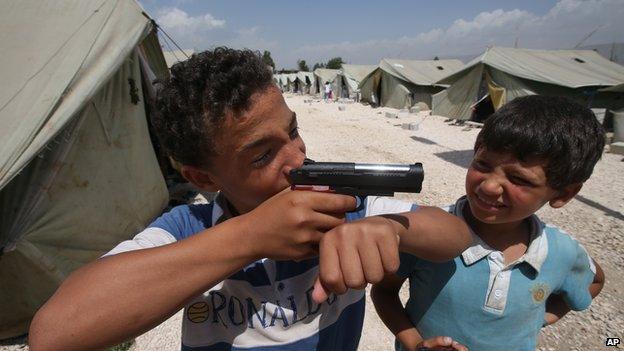Treatment 'toolbox' helps children combat war trauma
- Published

Many children around the world are caught up in conflict zones. These boys, who fled fighting in Syria, are in a refugee camp in neighbouring Jordan
Ayman is a 13-year-old boy living in a refugee camp in Jordan. He and his family used to live in a village near Homs, scene of some of the bloodiest fighting in Syria's civil conflict.
A missile landed on their home this year, prompting them to flee the fighting and join tens of thousands who have sought refuge in Jordan.
Memories of what Ayman witnessed have troubled him and his sister.
"They were crying a lot. They were sad and scared," said his mother Zeinab.
"My daughter started to chew her fingers and scream when someone knocked on the door or rang the bell."
Ayman is one of thousands of child refugees caught up in the violence. Many have had experiences like his.
Addressing their mental health needs usually falls to non-governmental organisations (NGOs) but now a new method could revolutionise the treatment of children in conflict zones.
The hope is that the fresh approach will mean large groups of children can be reached after wars and disasters, and that those at risk of mental health problems can be identified quickly.
Remarkable effects
Trained non-professionals teach children a variety of coping strategies through the Teaching Recovery Techniques manual, created by the Children and War Foundation.
The manual has been used with youngsters caught up in conflicts in Uganda, Sri Lanka and Gaza. Now it is being rolled out with Syrian refugees.
"It could make me forget the things that bothered me. I could forget them and get them out of my mind," said Ayman.
It's a simple idea: that, through these techniques, children can boost their own capacity to cope. It is having remarkable effects.
"It's like a toolbox of skills that they get. And it's skills for life," said Dr Atle Dyregov, director of the Children and War Foundation and one of the authors of the manual.
Conventional wisdom has been that children are resilient and "bounce back", but this is not universally so.
"Yes, children are resilient, but it's also a belief that adults want to hold because we don't have to take responsibility if we can say that children are resilient," said Dr Dyregov.
"So it's important for us to see that war affects children."
While many children caught up in conflict will develop their own coping strategies, the sheer volume who have witnessed terrible things means that a large number are facing serious mental health problems.
Moreover, recent research suggests that children's mental health needs in conflict are overlooked.
Intrusive images
One of the important things about the new manual is that it enhances more commonly used practices, such as asking children to draw or act out their traumas.
These non-verbal forms of expression are popular with many NGOs that provide care to children who have been in conflict zones. However, there are fears that this practice alone could actually leave children worse off.
"For a long period, like in the war in Yugoslavia, there was a lot of this getting children to play and to draw and, in itself, it doesn't bring down the trauma," said Dr Dyregov.
"If you have trauma effects, you need to do something more specific."
With the new manual, children are taught how to handle intrusive images and thoughts, through techniques based on cognitive behaviour therapy and skills such as relaxation and visualisation.
Equipped with these skills they can cope better with revisiting their traumas, such as through drawing or drama.
These are exactly the kinds of techniques that Ayman uses to help him forget the things that bothered him before.
His favourite is one where he visualises the traumatic image projected onto his hand and manipulates it as if on a computer screen.
"You imagine something that bothers you," Ayman said.
"Then you start to push it away with your hand. You maximise it or minimise it as you want, then you send this image back until it vanishes."
Other techniques in the manual include breathing and relaxation exercises, helping young people to visualise a chosen safe place that they love and can return to when they feel they are becoming stressed, or screwing up pictures that frighten them and drawing happy endings instead where children live happily ever after.
Training psychologists and teachers
But the manual is not a solution for every child who experiences war.
Nahmat, one of the course leaders in Amman, the Jordanian capital, who has been using the toolkit, says she has noticed changes in many of the children but not all.
"There are many now who say they have complete control over the images and the pain," she said.
"But some children are still severely affected and we refer them on to see a specialist."
However, as a first line of defence, toolkit training requires little infrastructure and can be rolled out quickly.
Local psychologists and teachers are easily trained in the techniques and they can rapidly reach hundreds of children and their parents who might otherwise suffer alone.
Dr Dyregov emphasises that reaching children offers a chance to prevent a serious mental health legacy of the conflict in Syria.
He says: "Governmental organisations and non-governmental organisations need to join forces because one of the best investments is helping the children who are facing war now."